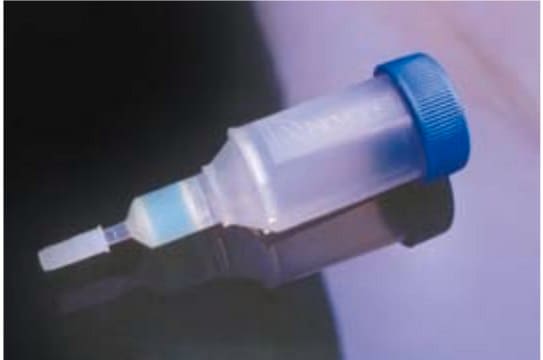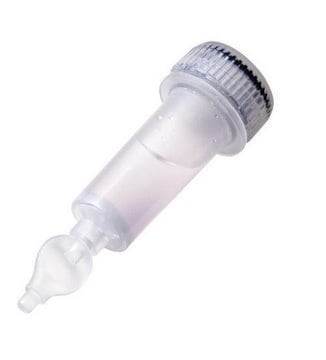Yes, Tris buffers should work.
P6611
HIS-Select® Nickel Affinity Gel
(1:1 suspension in a 20% ethanol solution)
Sinonimo/i:
Ni-NTA resin, nickel charged agarose
Scegli un formato
146,00 €
Scegli un formato
About This Item
146,00 €
Prodotti consigliati
Coniugato
magnetic beads
Livello qualitativo
Stato
(1:1 suspension in a 20% ethanol solution)
Caratteristiche
hydrophilic
Confezionamento
pkg of 1 mL
pkg of 100 mL
pkg of 25 mL
pkg of 5 mL
pkg of 500 mL
Concentrazione
1.5-2.4 mL/mL (suspension in packed gel)
tecniche
protein purification: suitable
Colore
faint blue to very dark blue
Matrice
6% Beaded Agarose
Capacità
>15 mg/mL, gel binding capacity (protein)(with an approx. 30 kDa protein)
Temp. transizione
flash point 32 °C (closed cup)
Temperatura di conservazione
2-8°C
Descrizione generale
Applicazioni
Caratteristiche e vantaggi
- High selectivity for higher purity.
- Unique non-charged hydrophilic linkage reduces non-specific binding.
- Binding capacity for histidine-tagged protein is greater than 15 mg/mL.
- Binding under denaturing or non-denaturing conditions.
- One-step purification.
- Minimizes unwanted ionic interactions.
- Minimal nickel leaching.
- Bead size: 45-165 μm.
Linkage
Stato fisico
Stoccaggio e stabilità
Note legali
Prodotti correlati
Avvertenze
Warning
Indicazioni di pericolo
Consigli di prudenza
Classi di pericolo
Flam. Liq. 3
Codice della classe di stoccaggio
3 - Flammable liquids
Classe di pericolosità dell'acqua (WGK)
WGK 3
Punto d’infiammabilità (°F)
89.6 °F - closed cup
Punto d’infiammabilità (°C)
32 °C - closed cup
Scegli una delle versioni più recenti:
Certificati d'analisi (COA)
Non trovi la versione di tuo interesse?
Se hai bisogno di una versione specifica, puoi cercare il certificato tramite il numero di lotto.
Possiedi già questo prodotto?
I documenti relativi ai prodotti acquistati recentemente sono disponibili nell’Archivio dei documenti.
I clienti hanno visto anche
Contenuto correlato
Tecniche, reagenti e protocolli per la purificazione di proteine ricombinanti mediante tecniche di cromatografia a scambio ionico, di esclusione dimensionale e di affinità.
Protein purification techniques, reagents, and protocols for purifying recombinant proteins using methods including, ion-exchange, size-exclusion, and protein affinity chromatography.
Protein expression technologies for various expression systems supporting research, therapeutics, and vaccine production.
Tecnologie per l'espressione di proteine con vari sistemi di espressione, a supporto della ricerca e della produzione di agenti terapeutici e vaccini.
-
Can Tris buffers be used instead of phosphate buffer for HIS-Select® Nickel Affinity Gel, Product P6611?
1 risposta-
Utile?
-
-
Can imidazole be used with HIS-Select® Nickel Affinity Gel, Product P6611?
1 risposta-
For column chromatography, no more than 20 mM is suggested in the extract, equilibration, and wash buffers to prevent non-specific binding of proteins. No more than 250 mM is suggested for the elution buffers. Many proteins will elute with imidazole levels as low as 100 to 200 mM. For batch methods the imidazole concentration may have to be reduced or eliminated.When a protein is expressed at low levels, the presence of the imidazole limits the binding of the protein in the batch method but not when used in a column.
Utile?
-
-
What is the Department of Transportation shipping information for this product?
1 risposta-
Transportation information can be found in Section 14 of the product's (M)SDS.To access the shipping information for this material, use the link on the product detail page for the product.
Utile?
-
-
What needs to be done if the HIS-Select® Nickel Affinity Gel, Product P6611, resin turns brown on reuse?
1 risposta-
During purification many protein extracts tend to discolor an affinity gel during the loading step. The original color will return after the wash or elution step. If the color is still not changing strip and recharge the affinity gel with nickel. Wash with EDTA and recharge with Nickel solution.
Utile?
-
-
Can I use SDS with HIS-Select® Nickel Affinity Gel, Product P6611?
1 risposta-
0.1% SDS has been used with some samples, with no adverse effects on the observed protein binding. However, SDS will effectively coat proteins and may block the binding to the column. It is probably very protein-specific and an SDS concentration that works for one protein may not work for another.
Utile?
-
-
Why won't my recombinant protein with a histidine-containing tag bind to HIS-Select® Nickel Affinity Gel, Product P6611?
1 risposta-
Verify the pH and composition of sample and equilibration buffers. Make sure there are no chelating or reducing agents present in the extraction buffer. If using the batch mode, remove imidazole. Run the affinity purification under denaturing conditions. Run a Western blot of the extract to verify that the recombinant protein is present.
Utile?
-
Filtri attivi
Il team dei nostri ricercatori vanta grande esperienza in tutte le aree della ricerca quali Life Science, scienza dei materiali, sintesi chimica, cromatografia, discipline analitiche, ecc..
Contatta l'Assistenza Tecnica.









